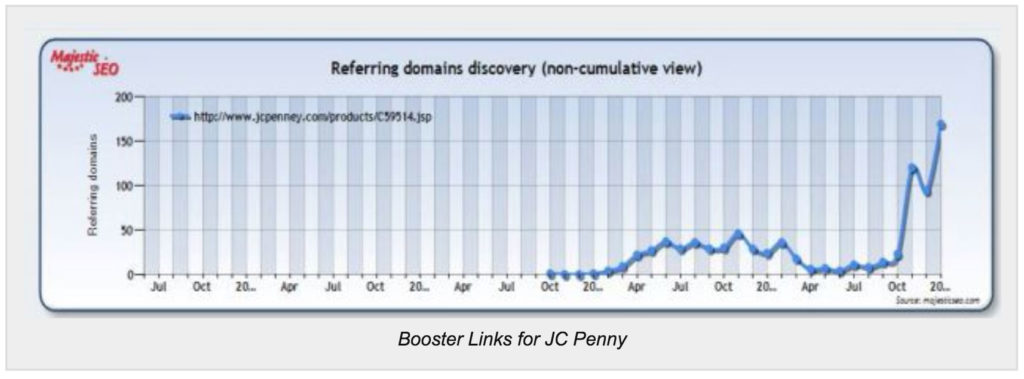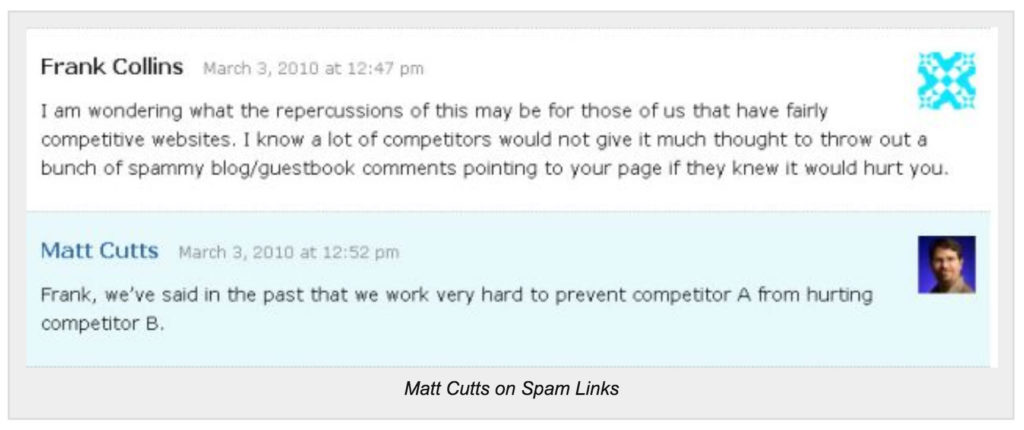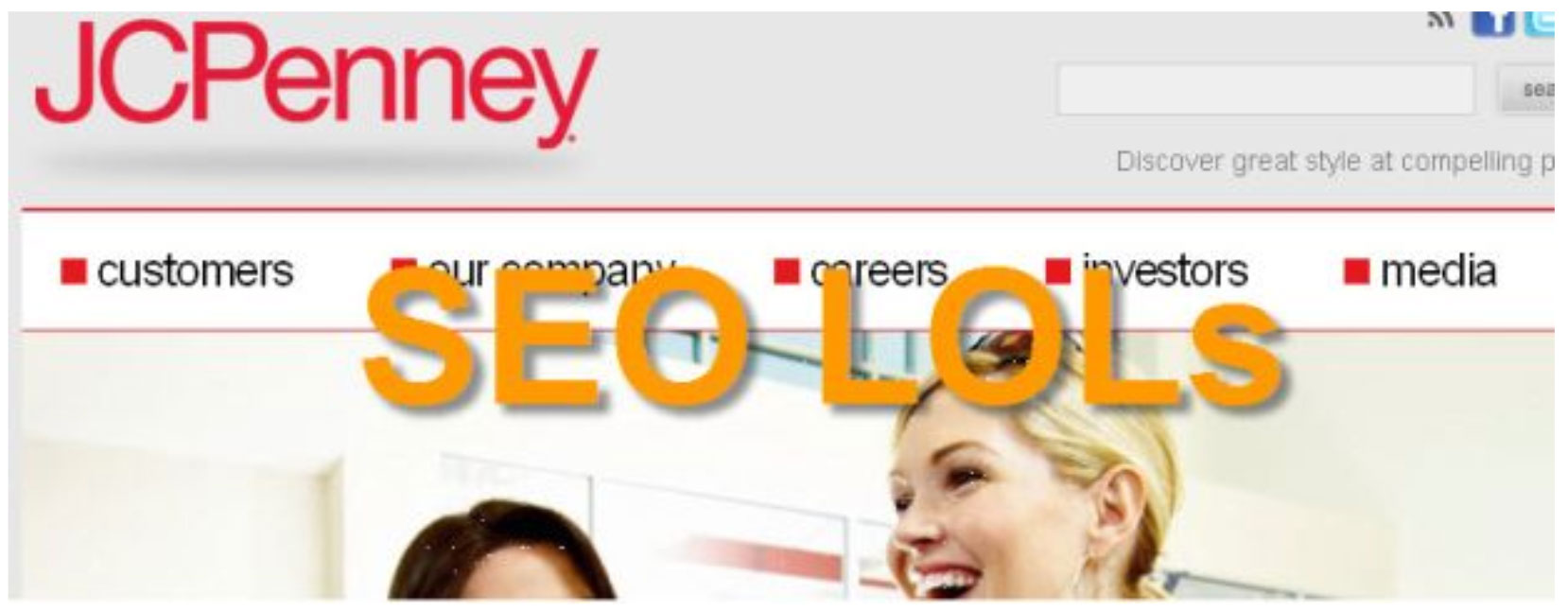You are probably bored reading about the JC Penney Fiasco. I know I was for a little while. But I couldn’t ignore this opportunity – it isn’t often that you get to see a Brand SEO campaign that is nearly burnt to the ground because of dodgy link building practices. You want a case study? Well it’s all in there. Intrigue, suspicion, politics, dirty PR, etc etc.
With such a high profile shame and name in SEO, what have you learnt? If you didn’t walk away with the following 10 learnings, you have wasted this wonderful educational opportunity.
a) – Link Farms Are Alive and Well
Doug Pierce, the SEO responsible for highlighting the poor SEO practices by JC Penney ran quite a detailed analysis of backlinks. After careful consideration, a number of these have come from the TNX network:
“The link came through a Web site, TNX.net, which pays Mr. Camichel with TNX points, which he then trades for links that drive traffic to his other sites, like cookingutensils.net. He earns money when people visit that site and click on the ads. He could also, he said, get cash from TNX. Currently, Cocaman is home to 403 links, all of them placed there by TNX on behalf of clients.”
We saw that this strategy gave JC Penney a massive boost. We saw that the traffic and revenue potential of the keywords it was targeting. We also know that this link net would probably have carried on until it was caught by a manual review – and that algorithmically it’s not easy to spot a link farm, if done well (and in instances even if done badly). For an over view of TNX, see this post.
b) Anchor Text Links Rule
This one is simple. In most cases many SEOs are going down the path of “Anchor Text is Dying”. It may be being degraded a bit in its value for ranking, however as this VERY recent example showed, the volume of anchor text still works.
c) Off Topic Links Hold Value
We are often told that the context of the area where we acquire links is extremely important. That the site, the age etc should be relevant to the linked to destination. The JC Penney scenario blew this out of the water. Is relevancy that important? For a sustainable strategy, absolutely. To pass human review, it’s a must. But for a quick win? Not so much.
As Search Engine Land puts it:
“Doug Pierce, who worked with New York Times to uncover what was happening with J.C. Penney … that the site had a LOT of links pointing to it. From peculiar sites. With very descriptive anchor text.” (emphasis mine).
d) The Art Of Booster Linking
Do you know what a booster linking strategy is? No? You should. This is the biggest lesson to those who haven’t run high scale brand and seasonal SEO campaigns. It has been the Gray Hat practice of a number of large brands to “acquire” volumes of links just before any large trading season. Normally this is put into place 3-4 weeks before and should ideally be eradicated almost immediately the end of the season, to avoid detection.
Branko Rihtman ran some of the URLs through Majestic SEO‘s link reporting tool and found that it appears that links were acquired in two bursts that coincided with the holiday seasons at the end of 2009 and 2010.

Booster Links for JC Penny
SEL showed us with the help of Branko (or @Neyne on twitter) when these links went up. Unfortunately they didn’t come down quick enough, to quote a Couple of Dave Naylor Tweets:
“they took a risk( calculated I hope), boost ranking for the holidays, they should have pulled the links down 2 weeks ago”
“…did you see the links? they were at best booster links, short term gains but long term NONOs”
Does this strategy work? I have seen proof that it does. And now with the JC Penney issue, You can all see it in action.
e) The Need For In-house SEOs
JC Penney has categorically denied the knowledge of the existence of paid links. They refuse to admit that they were aware what their SEO agency was doing to get them such stellar results. Giving them the benefit of the doubt, it highlights why all brands need an inhouse SEO to ask these relevant questions, even if they have an agency that does the SEO work. A real SEO would have spotted the bad linking practice and questioned it. The least they can do, as Econsultancy puts it, is to use some basic free tools to make sure that their strategies are on track.
As Doug puts it:
“Actually, it’s the most ambitious attempt I’ve ever heard of,” he said. “This whole thing just blew me away. Especially for such a major brand. You’d think they would have people around them that would know better.”
f) The Need For Contracts
So let’s assume that JC Penney are in fact LYING. Let’s assume that they KNEW what was going on. Where does that leave us? With one SEO agency that did as they were told, maybe even highlighted the dangers, and who now may have to shut down after such a visible destruction of their reputation.
“J. C. Penney did not authorize, and we were not involved with or aware of, the posting of the links that you sent to us, as it is against our natural search policies,”
Assuming that the above quote is false, then the agency should have something in writing, an email, a contract, a mutually agreed disclaimer highlighting the dangers of these bad links. If they did, then they could make a massive come back – proving that they did what their client ask. So protect yourself if a client asks for dodgy practices, despite being warned.
g) Google New Link Spam Algo
Interesting to me was a specific comment on the NYT piece and tweet from Matt Cutts.
“David Segal of the NYT discusses some blackhat SEO: http://goo.gl/RdnTi Google’s algorithms had started to work; manual action also taken.”
So the first part is the Google Algorithm “starting” to work. What were these algos? Considering that from what I have been reading, google has been concentrating on low quality Spammy sites, as well as maybe looking at content farms, what is this “new” algo that is looking at Spammy links? To highlight the NYT comment:
“He noted, too, that before The Times presented evidence of the paid links to JCPenney.com, Google had just begun to roll out an algorithm change that had a negative effect on Penney’s search results. (The tweak affected “how we trust links,” Mr. Cutts said, declining to elaborate.)”
So a new link detection algo. Maybe not strong enough to capture links like JC Penney’s in one sweep (hence the need for manual action) but a new spam link detection algo, which I don’t recall reading anywhere else about.
h) Google Manual Movements
The same tweet above also confirms Manual Action by the google Spam team.
This shouldn’t be news to you. Shouldn’t be news to any one. There have been countless stories about manual penalization, and recently, via googles “Bing Bait” fiasco, that these movements can happen upward or downward. Does anyone else need proof that Google can, and does manually influence organic results?
i) Negative Spammy SEO / j) Killing Competitors With PR
I have bunched these two learnings together because they work well togther. For years google says that Spammy links cannot hurt your site. Anyone who believes this must be insane. How does google determine via the algo WHO placed the Spammy link?

Matt Cutts on Spam Links
Lets assume, just for a second, that neither JC Penney nor their SEO agency were at fault here – someone used TNX to buy those links, and then leak the story out to the NYT, what would the result be? To quote neyne:
Dear @jcpennys, one of your competitors just did a hit job on you by the means of NYT article. A smart hit job at that.
And to summarize this joint strategy? Well Skitzzo puts it well:
How To Kill Competitors’ Rankings
- Buy spammy links to their site
- Get media to embarrass G about the spam
- Profit!
Finally – You may want to see Alan’s Post on JC Penney Has Bigger problems than paid links as well as JC Penneys Official Relpy regarding the Fiasco.
